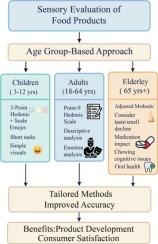不同年龄段食品感官评价方法综述
IF 8
1区 农林科学
Q1 FOOD SCIENCE & TECHNOLOGY
引用次数: 0
摘要
食品感官评价是了解消费者偏好和确保不同年龄组市场成功的关键工具。本文对儿童、成人和老年人的感官评估方法进行了综述,旨在为设计准确的问卷和选择合适的评估技术提供实用的解决方案。对于儿童来说,简化的快乐量表(如3分量表)和非语言技巧(如基于表情符号的评估和面部表情分析)是有效的,因为他们的语言和认知能力有限。成年人受益于综合方法,如9分享乐量表、描述性分析和情绪分析,这些方法提供了对偏好的细微见解。对于老年人来说,感官评估可以解释与年龄相关的嗅觉和味觉敏感性下降,以及药物和认知变化的影响。量身定制的方法,包括快速分析技术,如check - all - the - apply (CATA)和质地改良食品评估,对于满足他们的独特需求至关重要。这篇综述强调了适应每个年龄组的发育和生理特征的感官评估方案的重要性,为研究人员和行业专业人员提供了切实可行的建议,以提高产品开发和消费者满意度。本文章由计算机程序翻译,如有差异,请以英文原文为准。

Sensory evaluation methods for food products targeting different age groups: A review
The sensory evaluation of food products is a critical tool for understanding consumer preferences and ensuring market success across diverse age groups. This narrative review examined sensory evaluation methods tailored for children, adults, and the elderly, aiming to provide practical solutions for designing accurate questionnaires and selecting appropriate evaluation techniques. For children, simplified hedonic scales (e.g., 3-point scales) and nonverbal techniques such as emoji-based assessments and facial expression analysis were effective, given their limited verbal and cognitive capacities. Adults benefited from comprehensive methods like the 9-point hedonic scale, descriptive analysis, and emotion profiling, which provide nuanced insights into preferences. For the elderly, sensory evaluation accounted for age-related declines in olfactory and gustatory sensitivity, as well as the impact of medications and cognitive changes. Tailored methods, including rapid profiling techniques like Check-All-That-Apply (CATA) and texture-modified food evaluations, were essential to address their unique needs. This review highlighted the importance of adapting sensory evaluation protocols to each age group's developmental and physiological characteristics, offering practical recommendations for researchers and industry professionals to improve product development and consumer satisfaction.
求助全文
通过发布文献求助,成功后即可免费获取论文全文。
去求助
来源期刊

Food Research International
工程技术-食品科技
CiteScore
12.50
自引率
7.40%
发文量
1183
审稿时长
79 days
期刊介绍:
Food Research International serves as a rapid dissemination platform for significant and impactful research in food science, technology, engineering, and nutrition. The journal focuses on publishing novel, high-quality, and high-impact review papers, original research papers, and letters to the editors across various disciplines in the science and technology of food. Additionally, it follows a policy of publishing special issues on topical and emergent subjects in food research or related areas. Selected, peer-reviewed papers from scientific meetings, workshops, and conferences on the science, technology, and engineering of foods are also featured in special issues.
 求助内容:
求助内容: 应助结果提醒方式:
应助结果提醒方式:


